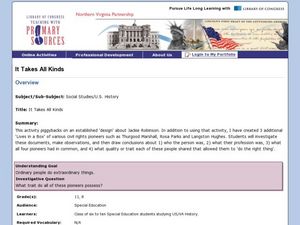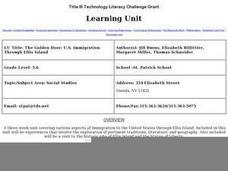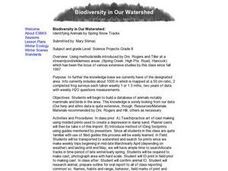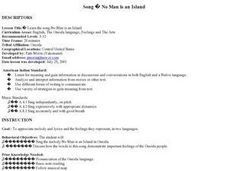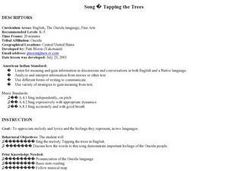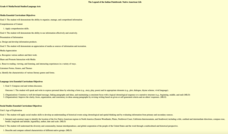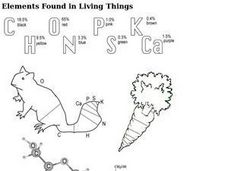Curated OER
It Takes All Kinds!
Students view video clips and observe similarities and differences between animals. They sort animals into groups for a zoo. They make a graph of their observations and review scientific classifications.
Curated OER
The Golden Door: U.S. Immigration Through Ellis Island
Students complete a unit covering various aspects of immigration to the United States through Ellis Island. They plan a fictional trip to America, entering at Ellis Island. and actually visit Ellis Island and the Statue of Liberty.
Curated OER
Who We Are: To Know the Characteristics of a Population Within Certain Domains
Learners, through research, discover the characteristics of the population of Quebec and compare them to those of Canada as a whole. They create a class presentation about information they found.
Curated OER
Biodiversity in Our Watershed
Eighth graders create a database of animals and birds in the area in which they live. They use molded prints to make a cast of an imprint from a specific animal. They identify and research animals and prepare an outline for an oral...
Curated OER
Math: A Geometric Neighborhood
Learners, as a final project, draw a picture of their ideal neighborhood on a sunny day. In addition to the sun, their drawings include homes, trees, streets, and selected objects. Each object in their drawing has a written description...
Curated OER
Here We Go Round the Apple Tree
The students sing the melody Here We Go Round the Apple Tree in the English language and the Oneida language. The students then discuss how the words to this song demonstrate important feelings of the Oneida people.
Curated OER
Song Allouette - Oneida
Students practice singing the song Allouette. They discuss the meaning in both the English and Oneida languages and how the words to this song demonstrate important feelings for the Oneida people.
Curated OER
No Man is an Island
Students sing the melody of the song, "No Man is an Island," in the Oneida native language. They memorize the song and discuss how the words demonstrate important feelings of the Oneida people.
Curated OER
Music ; Oneida Harvest Song
Students practice singing the harvest song in their native Oneida language and English. They sing the lyrics to the melody of "Children Go Where I Send Thee." Students discover the meaning of the song as it expresses thankfulness to...
Curated OER
Music - Touch the Wind
Students study the Oneida song "Touch the Wind". They discuss the meaning and sentiment of the piece. Students use important singing techniques including good breathing, dynamics, and pitch. Students illustrate of the meaning of the song.
Curated OER
Ta he thaw nu ha la tu-Traditional Oneida Song
Learners practice singing a traditional Oneida song. They discuss the meaning in both the English and Oneida languages and how the words to this song demonstrate important feelings for the Oneida people.
Curated OER
Tapping the Trees-Traditional Oneida Song
Students practice singing the song, Tapping the Trees. They discuss the meaning in both the English and Oneida languages and how the words to this song demonstrate important feelings for the Oneida people.
Curated OER
State Of The Bay
Students investigate the environmental problems that surround the Chesapeake Bay area. They use an environmental handout as a resource that should be supplemented with research. Also students ask specific questions to report findings and...
Curated OER
The Legend of the Indian Paintbrush: Native American Life
Students read," The Legend of the Indian Paintbrush" by Tomie dePaola and discuss the way legends are passed down orally. They then create their own legend and illustrate it on a simulated "Buffalo Skin" made from brown paper.
Curated OER
Snail Observation Exercise
Students are given a pond snail in a clear glass and asked to make observations on the snail's form and behavior. One of the key ideas is that seemly common subjects (like snails) often have surprising or interesting properties.
Curated OER
Current Interactions
High schoolers design an experiment to see how wind, temperature, and salinity work together to influence ocean currents and present it in a report format. They explain to their classmates how experiment findings relate to ocean currents.
Curated OER
Count Down
Students are introduced to useing websites as a data source. Using bird population predictions, they test their predictions from various websites. They record, organize and graph the data and share their results with the class.
Curated OER
Hurricanes-Disasters In the Making
Sixth graders discover the proper methods for plotting hurricanes while developing their understanding of hurricanes by researching and gathering tracking data from technological sources. Students develop a newsletter about hurricanes,...
Curated OER
A Study of Genocide and Project for Rememberance
Tenth graders examine the mass execution of Ukranian Jews by the Nazis at Babi Yar through a variety of sources, including: music, poetry, primary sources and photographs. They also design a memorial for the victims.
Curated OER
Fossils
Fourth graders act as paleontologists and attempt to figure out the environment where various fossils would have existed. They explain how fossils can be used to make inferences about past life, climate, geology, and environments.
Curated OER
Earthquake Unit
Eighth graders watch the "Earth, the Environment & Beyond" video on earthquakes. Take notes and give an oral summary. They build a working, two dimensional model of a strike-slip, thrust, or normal fault.
Curated OER
Acids and Alkalis
Students determine and explain the characteristics of alkalis and acids. With their list of characteristics student groups conduct an investigation into whether various household substances are alkali or acid. Their lab findings are...
Curated OER
What are Quarters Made of?
Young scholars study the meaning, symbolism, and value of U.S. coins,
especially the quarter. They l research why in 1965 the U.S. Mint decided to
change the metal composition of the quarter to copper coated with zinc. In addition, they...
Curated OER
Elements Found in Living Things
In this elements worksheet, learners review the most common elements found in living things. Students color in two pictures with the percentages of the elements found in that living thing.
Other popular searches
- Using a Map Scale
- Map Scale Worksheets
- Map Scale Activities
- Geography Map Scale
- Map Scale Math Lessons
- Map Scale Math
- Geography Map Skills Scale
- Math Map Scales
- Map Scale Lesson Plans
- Using Map Scales
- Reading a Map Scale
- Using Map Scale Distance


